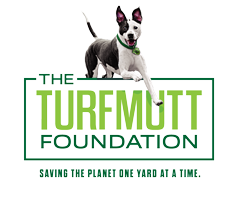Latest Posts
- Have a purpose when backyardingAugust 5 2021
- Study: Time outside alters our microbiomeAugust 4 2021
- Happy National Mutt Day from Mo-MoJuly 27 2021
- New home? Avoid these common mistakes in your yard.July 26 2021
- Infographic: Plan a backyard staycation this summerJuly 22 2021
Categories
Archive
October 1st
TurfMutt Program Educates Kids
Heat, imbalance in Co2, contaminants from water runoff, and dust and other particulate matter in the air can create environmental problems for us all. The TurfMutt educational program, which partners with Discovery Education, uses the four characters below to help educate youth on common foes that are combatted by green space. The program helps them understand that the everyday environment around them battles common “villains” and shows some of the contributions of parks, recreational areas and even their own backyard.
 King of Heat Islands. Heat islands are bare spots like parking lots and built up parts of cities that absorb the sun’s heat and then give it off into the air. They can raise air temperatures by 22*F more than in nearby planted, grassy areas — and increase air pollution. But grass blades act like a mini-cooler, producing moisture and absorbing heat. On a really hot day, lawns can be 31*F cooler than asphalt and 20*F cooler than bare soil.
King of Heat Islands. Heat islands are bare spots like parking lots and built up parts of cities that absorb the sun’s heat and then give it off into the air. They can raise air temperatures by 22*F more than in nearby planted, grassy areas — and increase air pollution. But grass blades act like a mini-cooler, producing moisture and absorbing heat. On a really hot day, lawns can be 31*F cooler than asphalt and 20*F cooler than bare soil.
![]() Founder of the Foul Footprint. You’ve heard about climate change. One reason many scientists say our planet is heating up is the building in our atmosphere of a gas called carbon dioxide. Plant some green! Lawns pull carbon dioxide from the air and store it. In the U.S., turfgrass grabs and stores more than eight million tons of carbon every year.
Founder of the Foul Footprint. You’ve heard about climate change. One reason many scientists say our planet is heating up is the building in our atmosphere of a gas called carbon dioxide. Plant some green! Lawns pull carbon dioxide from the air and store it. In the U.S., turfgrass grabs and stores more than eight million tons of carbon every year.
 A “Pour” Role Model. A big cause of water quality problems is runoff of contaminants – like chemicals. Rainwater “runs off” hard surfaces, such as roads and parking lots, into waterways. Run -off can be reduced by planting new lawns and landscape areas. Grass absorbs rainwater. It can make rainwater 10 times less acidic than water running off a hard surface. This protects our rivers and streams.
A “Pour” Role Model. A big cause of water quality problems is runoff of contaminants – like chemicals. Rainwater “runs off” hard surfaces, such as roads and parking lots, into waterways. Run -off can be reduced by planting new lawns and landscape areas. Grass absorbs rainwater. It can make rainwater 10 times less acidic than water running off a hard surface. This protects our rivers and streams.
 Fan of Blowing Away Soil. Soil erosion is a big issue. Nearly six billion tons of bare soil wash or blow away each year. Dust in the air damages the environment – and hurts those with asthma and allergies. Turfgrass is the best defense against erosion and holds the soil better than any other plant because of its giant root system. A single grass plant can have more than 300 miles of roots!
Fan of Blowing Away Soil. Soil erosion is a big issue. Nearly six billion tons of bare soil wash or blow away each year. Dust in the air damages the environment – and hurts those with asthma and allergies. Turfgrass is the best defense against erosion and holds the soil better than any other plant because of its giant root system. A single grass plant can have more than 300 miles of roots!





